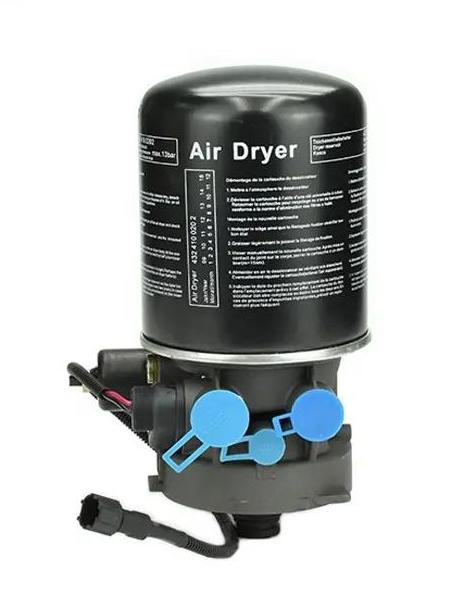
Component Durability for Extreme Terrain
The dynamics of heavy vehicle operation change dramatically when traversing mountainous terrain and steep gradients. On level ground, the braking system manages speed reduction and stopping; on significant downward slopes, it is suddenly burdened with the colossal task of continuously dissipating the kinetic energy of a fully loaded vehicle. This continuous energy conversion, primarily through friction, generates extreme heat, a phenomenon that directly threatens the integrity of the brake system and can rapidly lead to catastrophic brake fade. Therefore, the strategic selection of robust, high performance components is not merely a preference but a mandatory safety and operational requirement for any fleet engaged in mountain hauling. Maintaining control and compliance requires an absolute focus on thermal stability, component durability, and the flawless operation of both service and auxiliary braking mechanisms.
Managing Thermal Stress and Brake Fade
Brake fade occurs when the intense heat generated during prolonged downhill braking exceeds the design capacity of the friction components. As the temperature rises, the coefficient of friction between the braking surfaces decreases, and in drum brake systems, the brake drums themselves expand, moving away from the brake shoes, linings & kits. This expansion necessitates greater pushrod stroke from the brake chambers to achieve even minimal braking force. This escalating demand for force ultimately leads to a severe loss of stopping power.
Key components critically affected by thermal stress include:
- Brake Discs and Brake Drums: These metal surfaces are the primary heat sinks. High quality brake discs and brake drums are engineered with specialized metallurgy to withstand repeated thermal cycling without warping or cracking, ensuring dimensional stability.
- Friction Materials: The composition of the brake shoes, linings & kits dictates their high temperature performance. Superior materials retain their friction properties at elevated temperatures, effectively delaying the onset of fade and providing a crucial safety margin on extended descents.
- Hydraulic and Air Systems: Excessive heat can transfer to associated components. The reliability of brake valves and the necessary control systems is essential to modulate the high pressures required under strenuous conditions without mechanical failure.
The selection of components designed specifically to manage this extreme heat transfer is the first defense against thermal stress and the operational risk it creates.
Air System Integrity and Air Dryers

The air brake system relies entirely on a clean, consistent supply of compressed air to power its final actuators. In all operating environments, but particularly in high altitude, variable climates, the threat of moisture contamination is constant. Air compresses easily, but water vapour does not, and it presents two significant risks: freezing and corrosion.
The air dryers are a foundational component for ensuring system health and continuous performance.
- Moisture Removal: Air dryers filter the compressed air, removing water vapour, oil aerosols, and particulates before the air enters the reservoirs. This prevents internal corrosion of sensitive metal components like control valves and brake valves.
- Preventing Freezing: In cold mountain climates, moisture in the air lines and brake valves can freeze, blocking air passages and rendering portions of the brake system inoperable. Effective air management, starting with the air dryers, eliminates this hazard.
- System Integrity: Clean air ensures that components operate within their intended tolerances. This preserves the functionality of elements like solenoids and the internal seals within diaphragm & seals used in various braking assemblies, supporting the overall integrity of the air breaks system.
A dependable, heavy duty air dryer is a non negotiable requirement for mountain fleets, safeguarding the reliability of the entire air breaks network against environmental factors.
Drivetrain's Role in Auxiliary Braking
While the service brakes manage the majority of speed reduction, successful mountain hauling depends heavily on auxiliary braking, which acts through the drivetrain. Engine braking, or retarding, relies on the mechanical integrity of the entire power transmission system to safely slow the vehicle.
The reliability of the drivetrain must be ensured through the use of durable components:
- Clutch Integrity: During gear changes, particularly downshifts necessary for engine braking, the clutches must manage extreme torque loads. High performance clutches are designed to absorb and transmit these forces reliably without slipping or suffering premature wear.
- Transmission Endurance: The transmissions themselves endure significant stress as the primary component converting the engine's resisting force into wheel resistance. Their structural parts and internal lubrication must be robust to handle sustained operation in lower gears.
- Axle and Bearing Resilience: The final transfer of this retarding force is through the u joints and axles to the wheels. High quality axles and accompanying bearings must be able to withstand the continuous stress reversals typical of mountain driving without overheating or suffering structural fatigue.
The integrity of the engine parts and associated power components, including the turbo charger, directly enables the safe use of engine retardation, preventing the overuse of friction brakes.
Chassis and Load Stability
Mountain roads are characterized not only by severe gradients but also by constant changes in camber, elevation, and frequent sharp turns. Vehicle stability is paramount to prevent rollovers and maintain control, making the selection of high quality chassis and suspension components equally critical.
Robust chassis and suspension are necessary to manage the dynamic forces of mountain driving:
- Suspension Parts and Air Springs: The suspension system, often including air springs, must manage shifting loads and absorb shock from uneven surfaces without compromising vehicle stability. Durable suspension parts maintain the correct ride height and stability, which is essential for consistent braking force distribution.
- Structural Connections: The fifth wheel assembly connecting the trailer to the tractor must be of superior quality to manage the constant pitching and yawing movements on steep, winding roads. Its locking mechanisms must maintain structural integrity under continuous, heavy loads.
- Steering and Alignment: Components affecting steering, such as ball joints and other precise mechanical assemblies, must withstand cyclical stresses to maintain accurate wheel alignment, crucial for safely navigating tight curves.
These foundational parts ensure the vehicle remains stable, allowing the driver to fully utilize the braking system when necessary.
All Truck Parts Limited: A Partner in Component Reliability
Achieving the level of reliability and durability required for mountain and steep gradient hauling demands a commitment to stringent manufacturing standards and a comprehensive understanding of severe operating conditions. This commitment is the defining characteristic of All Truck Parts Limited.
For over two decades, ATP has been a trusted component manufacturer focused on enhancing operational longevity and transport safety within the heavy duty sector. The company's adherence to the global ISO/TS16949 quality certification ensures that every product, from the smallest solenoid to the largest axles, meets rigorous international performance criteria. ATP’s strategic strength lies in its ability to provide a seamless, integrated supply solution designed for maximizing fleet uptime and minimizing lifetime operational costs.
ATP offers comprehensive product and service solutions for global commercial vehicle fleets:
- Component Inventory: The firm supplies a complete line of heavy duty vehicle components, covering every major system, including various filters, motor oils, and full kits for air breaks and abs breaks. Specialized components like light duty brake shoes and electric & electrical parts are also stocked.
- Integrated Supply Model: Operating as a one stop solution, ATP eliminates logistical complexity by providing genuine factory direct prices and consolidated supply. This model supports rapid fulfillment and ensures quick delivery of critical parts worldwide.
- Engineering and Quality Assurance: With a dedicated team of advanced engineers, ATP offers customized design and OEM/ODM capabilities. Every part is backed by a full warranty, confirming the product's quality and its engineered reliability for severe service.
- Chassis and Drivetrain: The inventory extends to crucial structural and power transmission parts, including various body parts, wheels, tires, and all necessary hardware kits for installation and maintenance.
This integrated approach guarantees that fleets receive not only the required component but also the engineering confidence necessary for safe and compliant operation in the world’s most demanding environments.
Conclusion
The successful operation of commercial fleets across steep gradient and mountain terrain fundamentally rests on component quality and engineering foresight. The extreme thermal and mechanical stresses inherent to these environments demand a robust and reliable braking system, supported by an equally resilient drivetrain and chassis. By prioritizing components engineered for thermal stability and high load cycling, fleet operators can effectively mitigate the risk of brake fade and ensure continuous vehicle control. The ability to source high quality, warrantied components, ranging from brake discs and brake drums to crucial air dryers and axles, through a single, accountable supplier is the most effective strategy for securing long term safety, regulatory compliance, and maximum operational uptime in severe service hauling.




